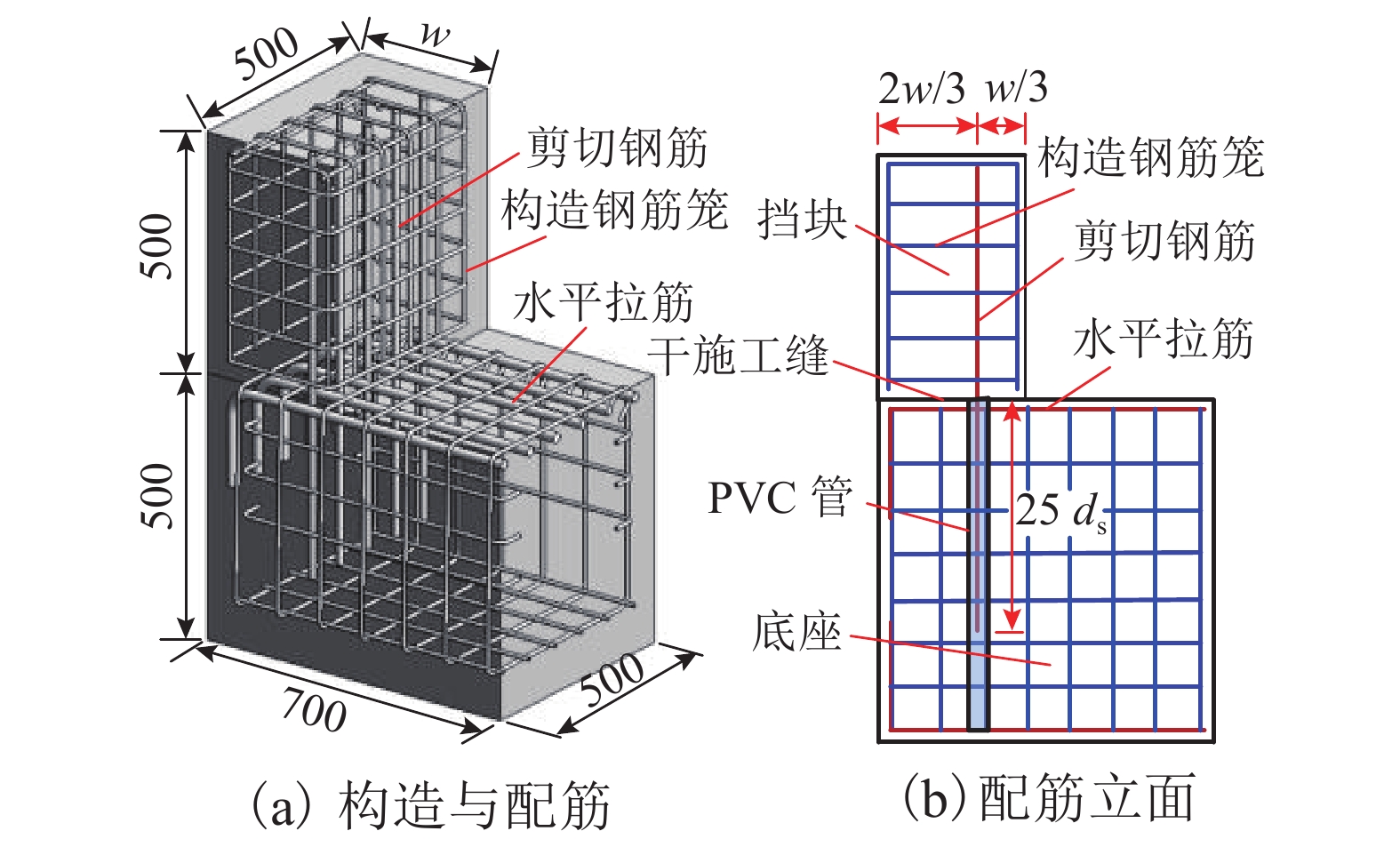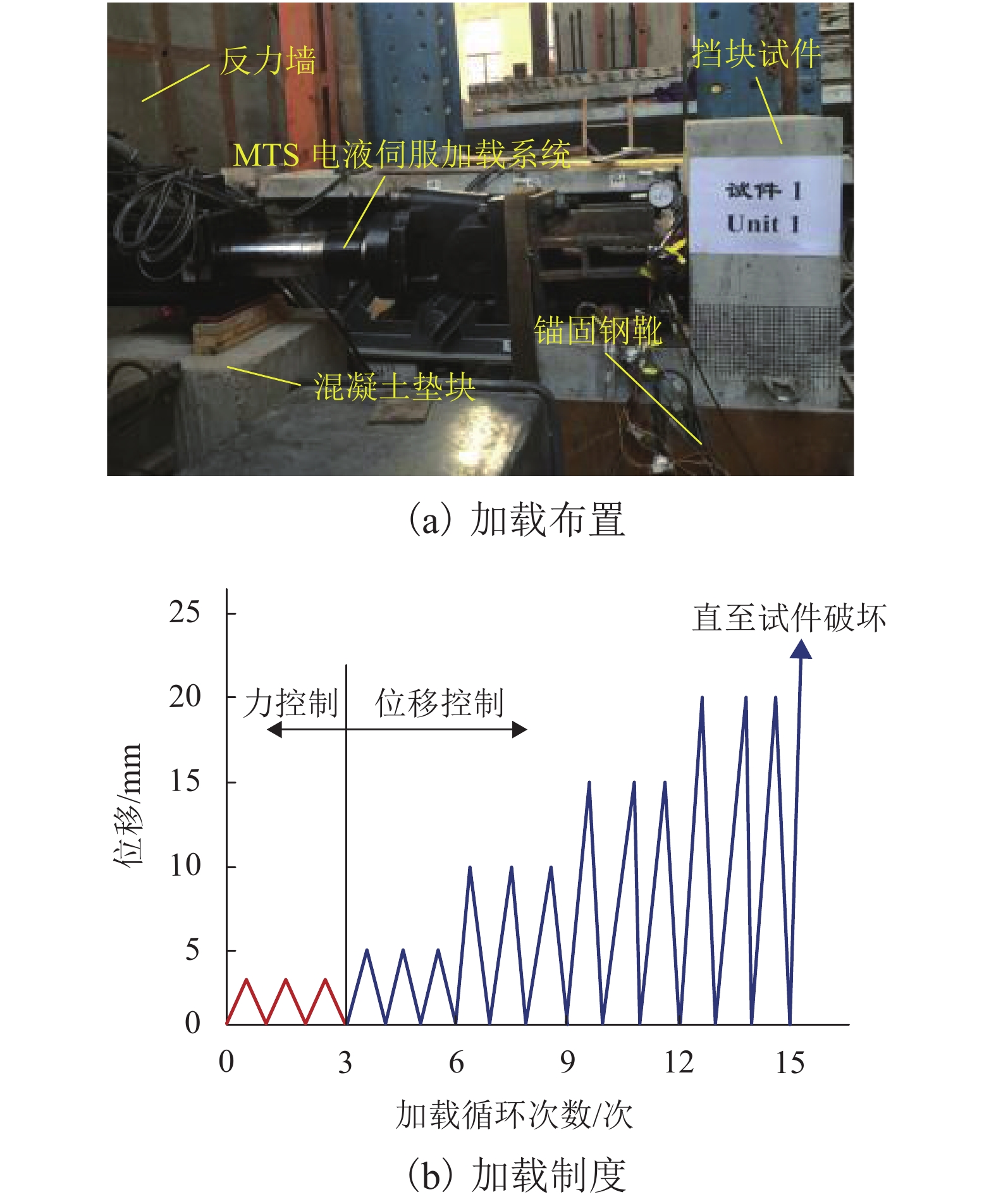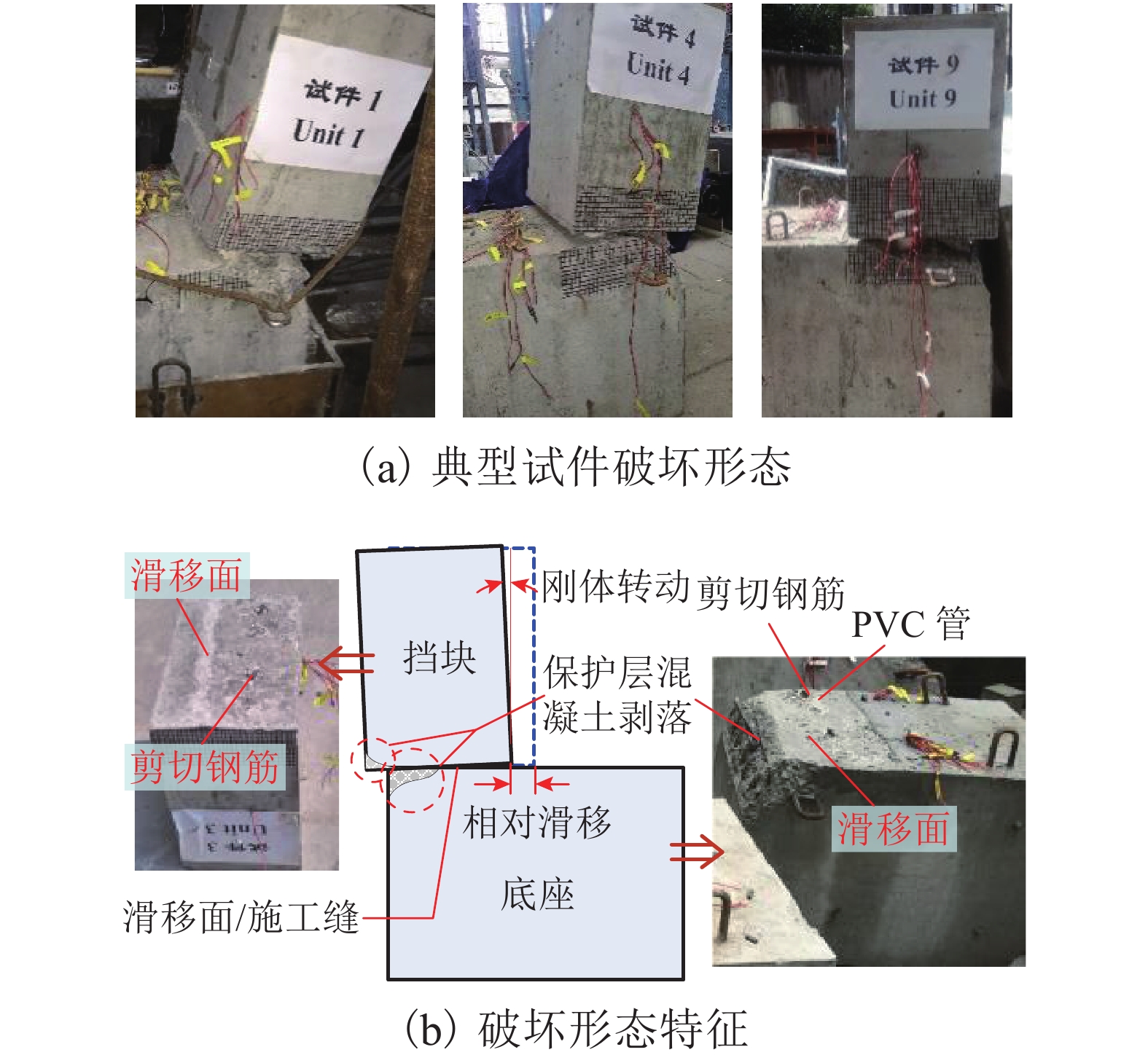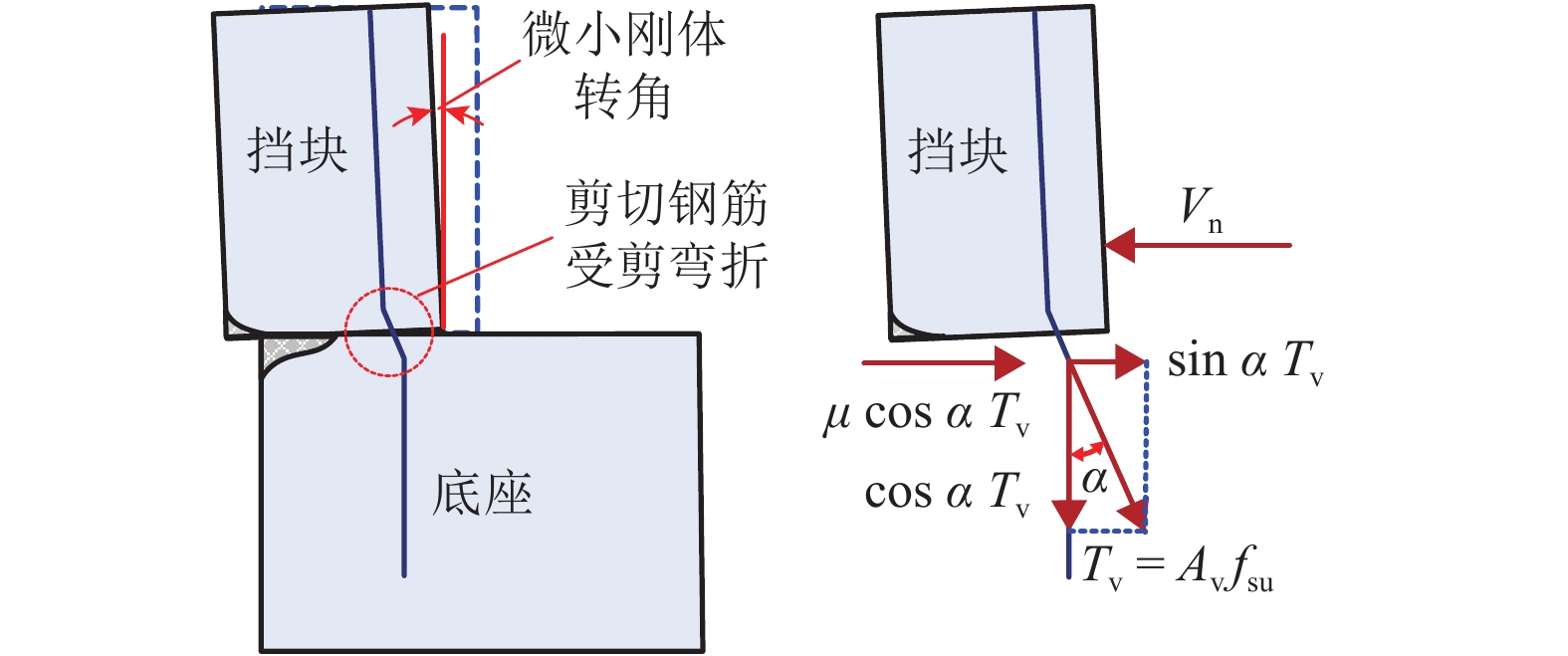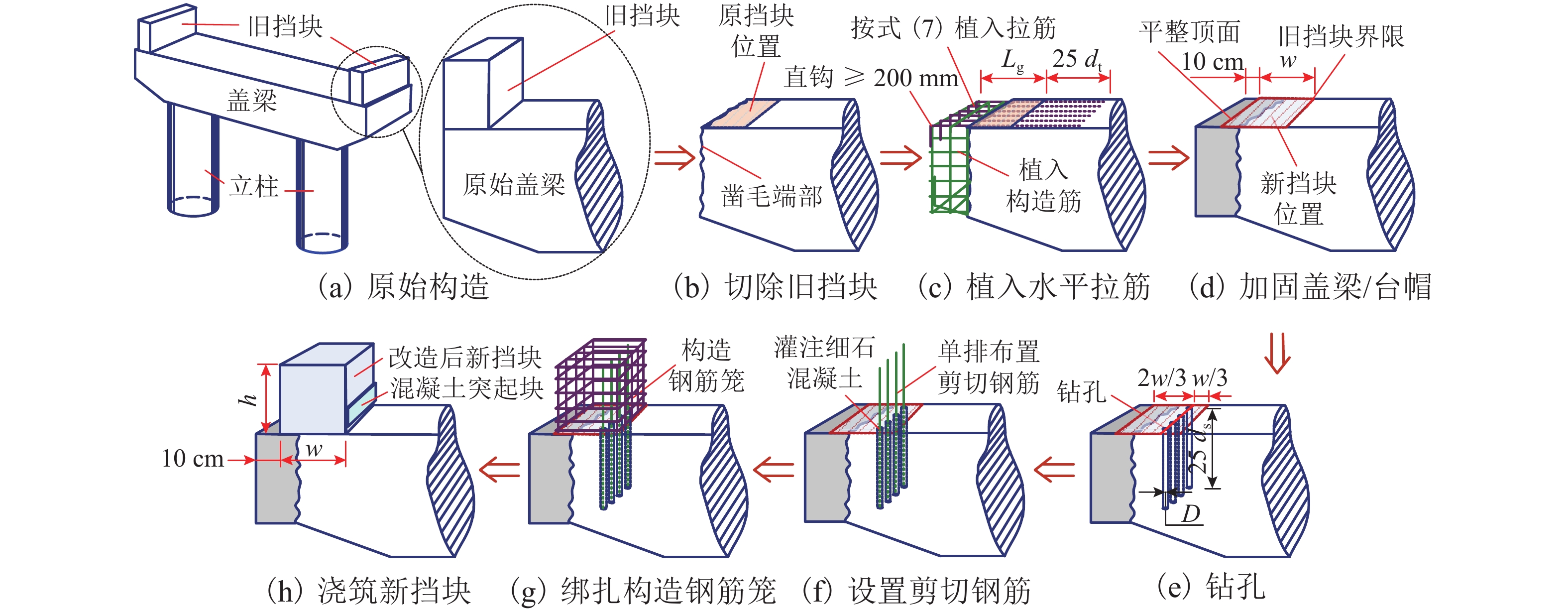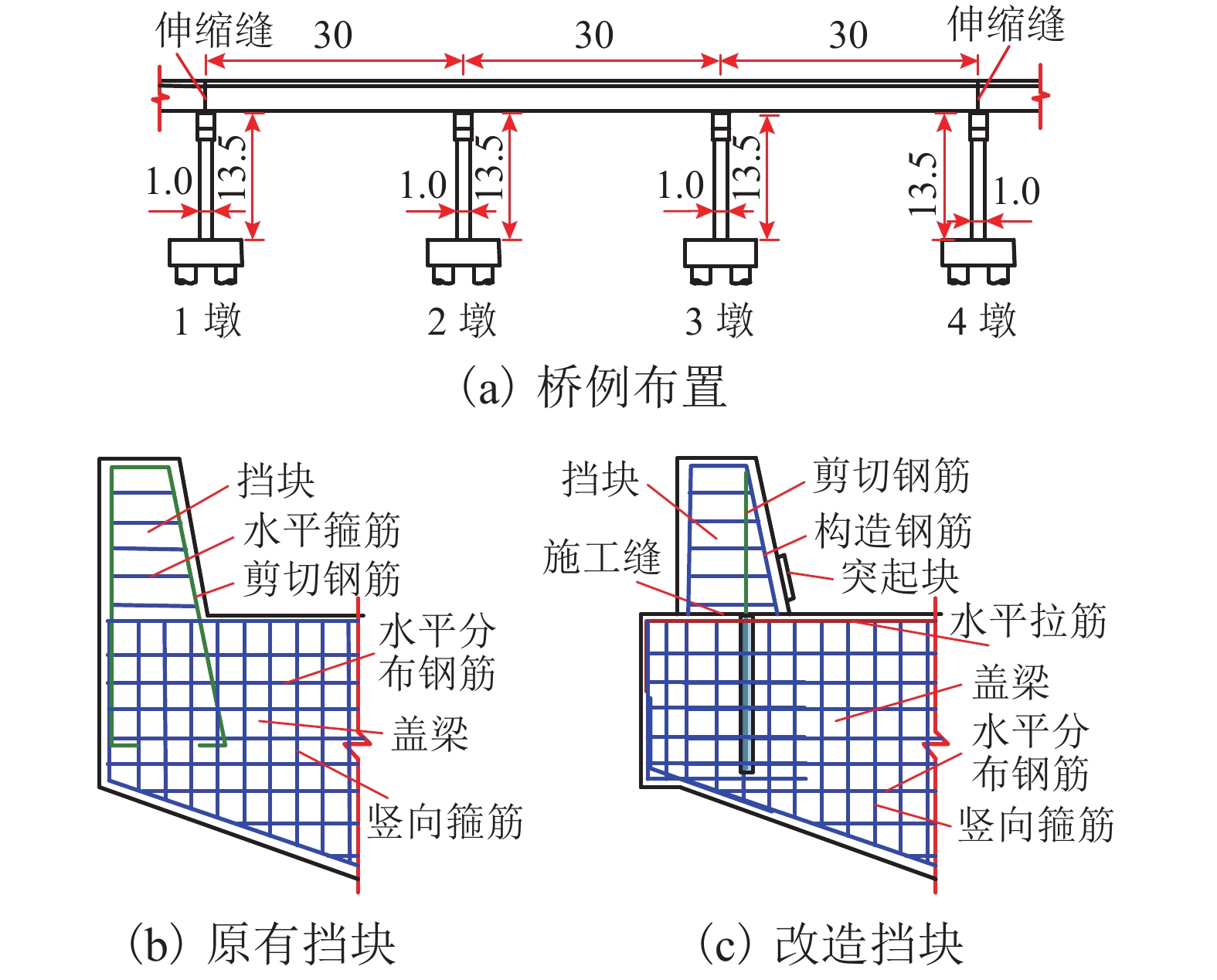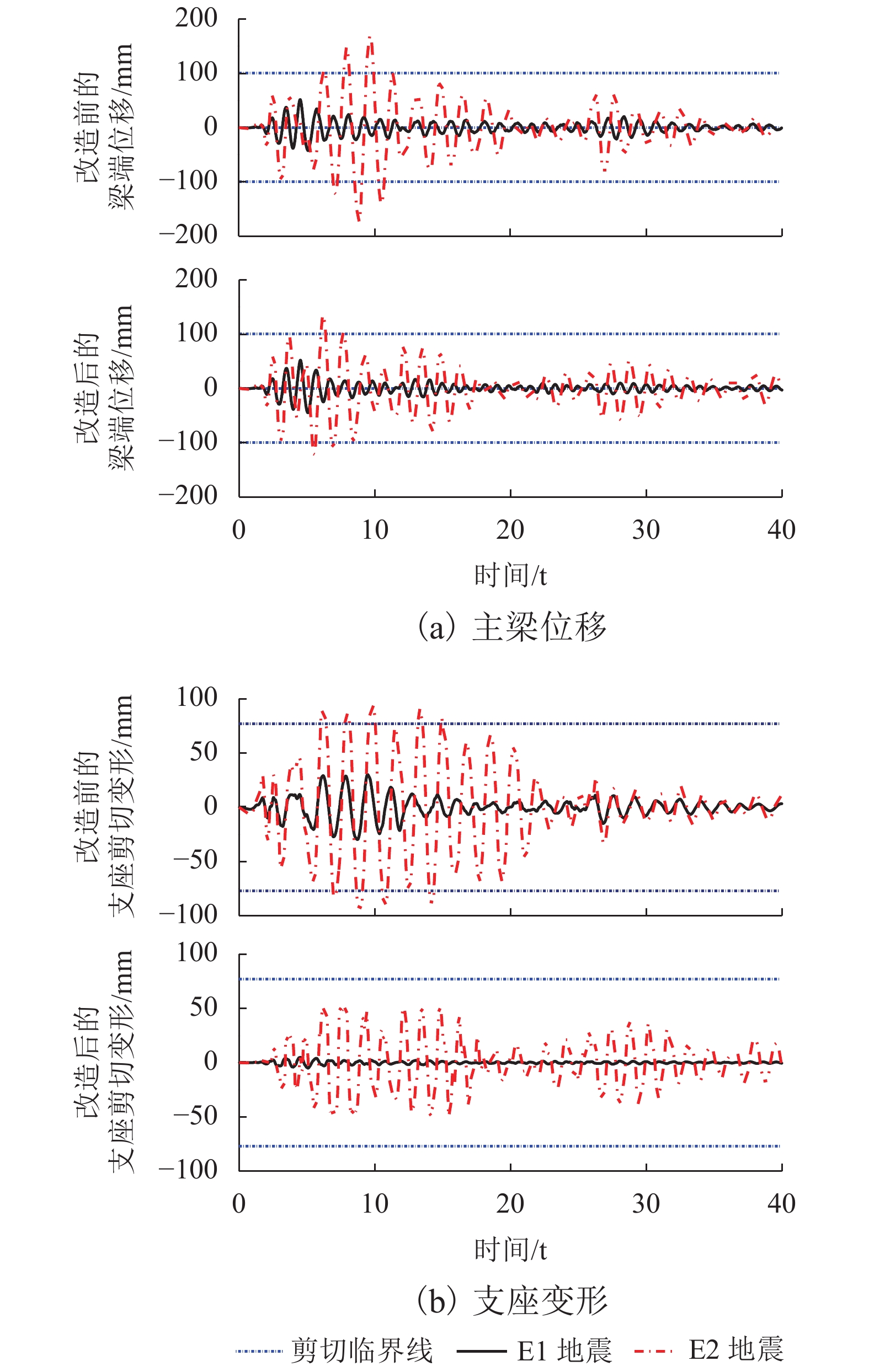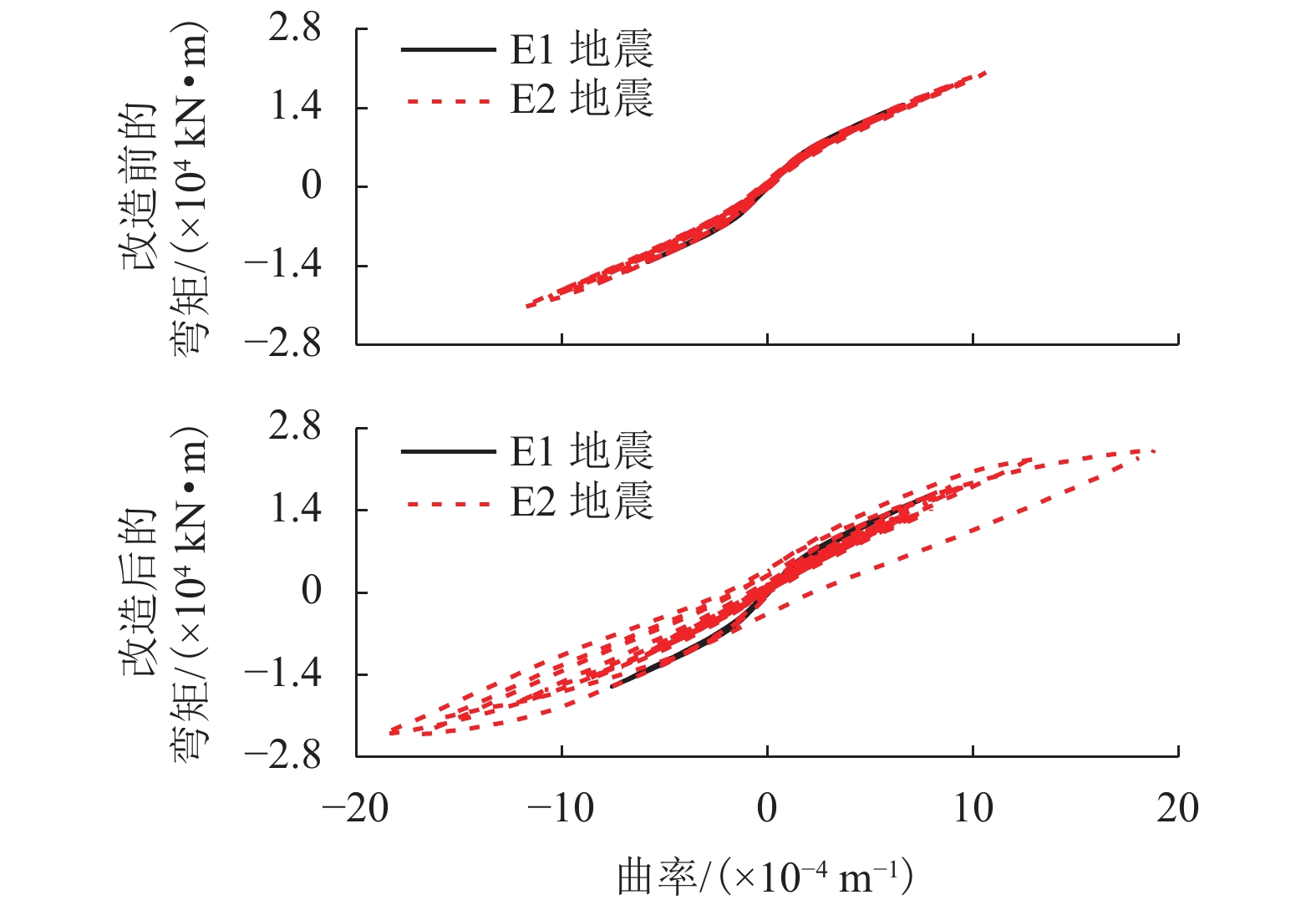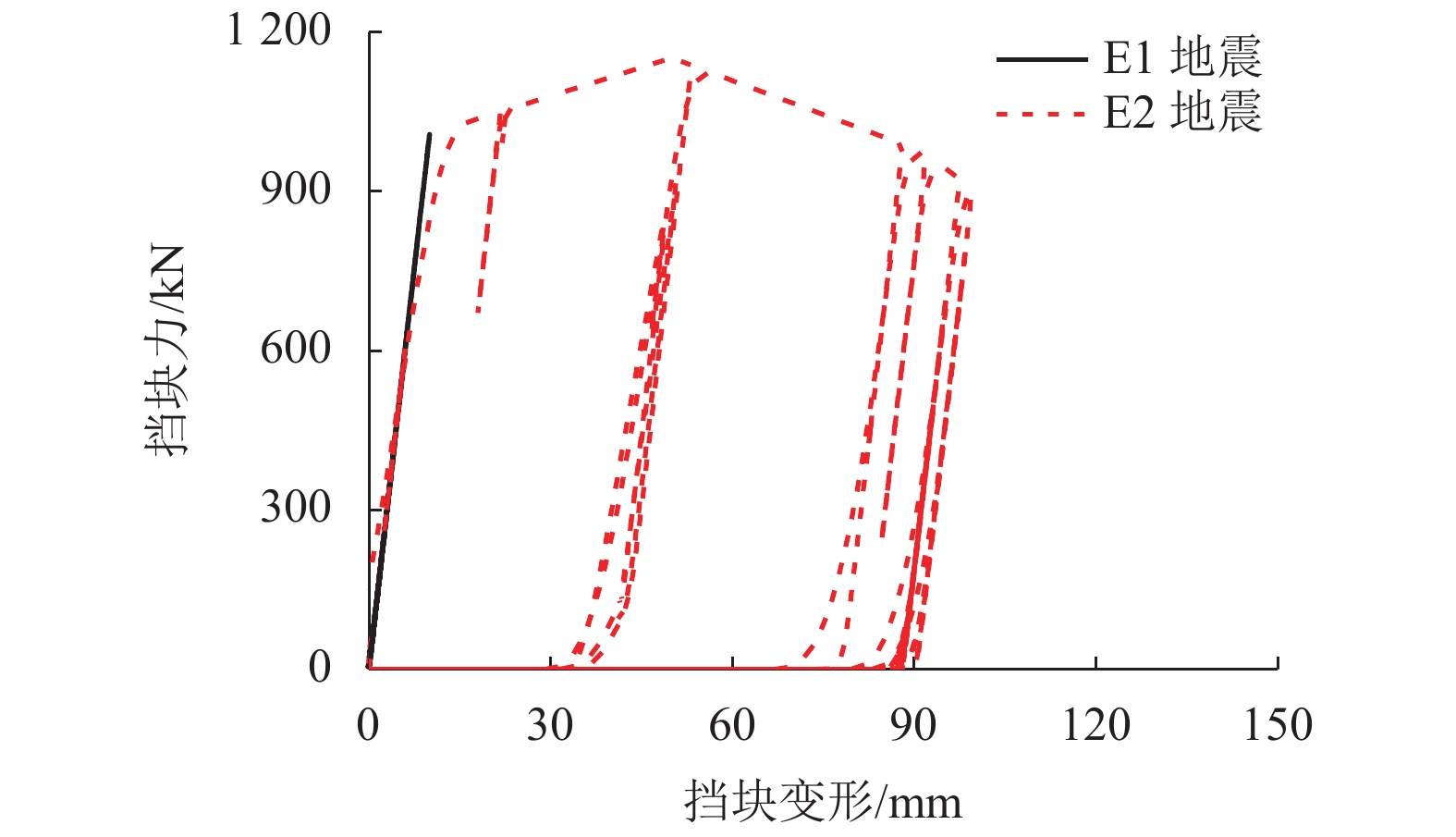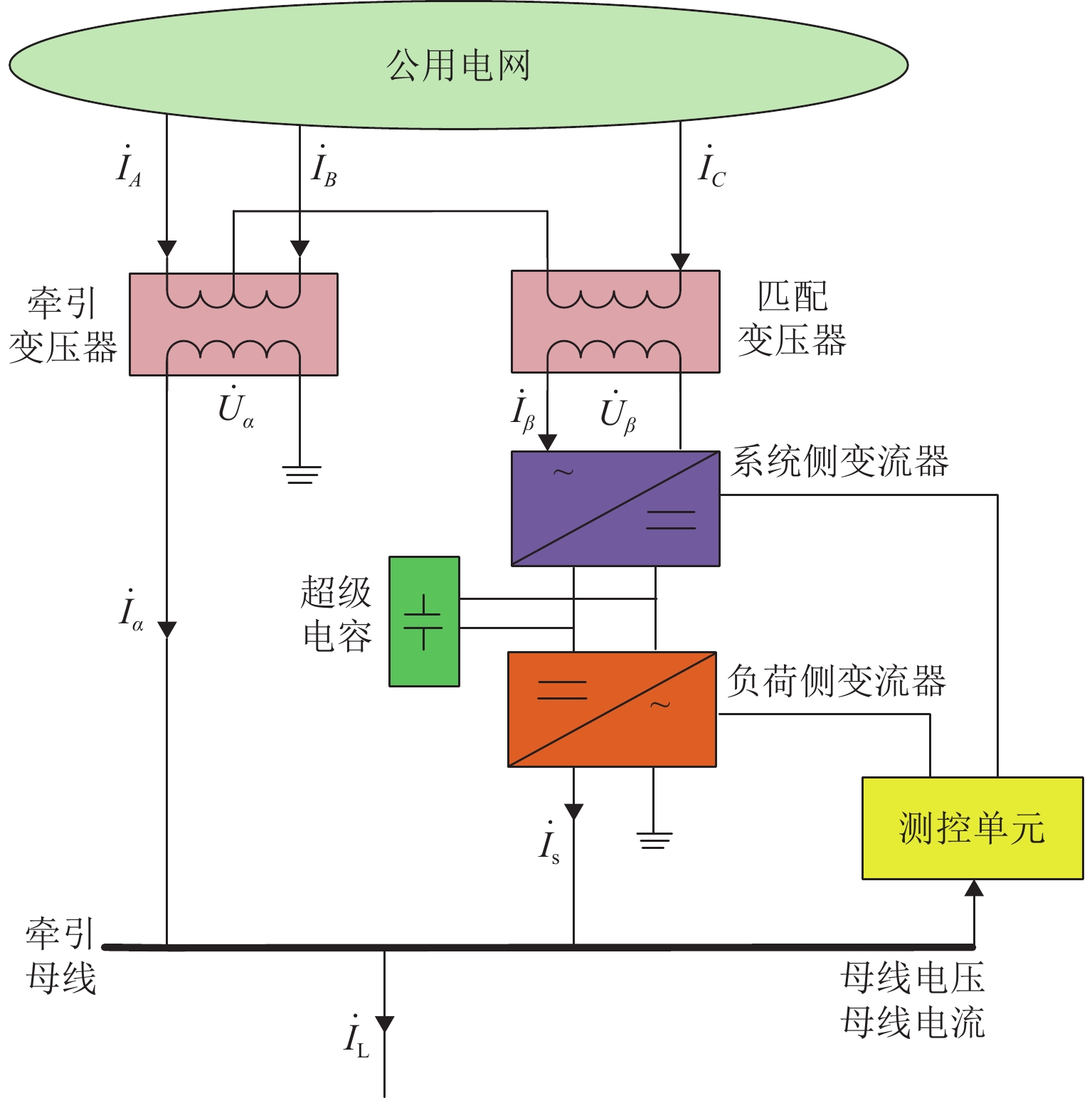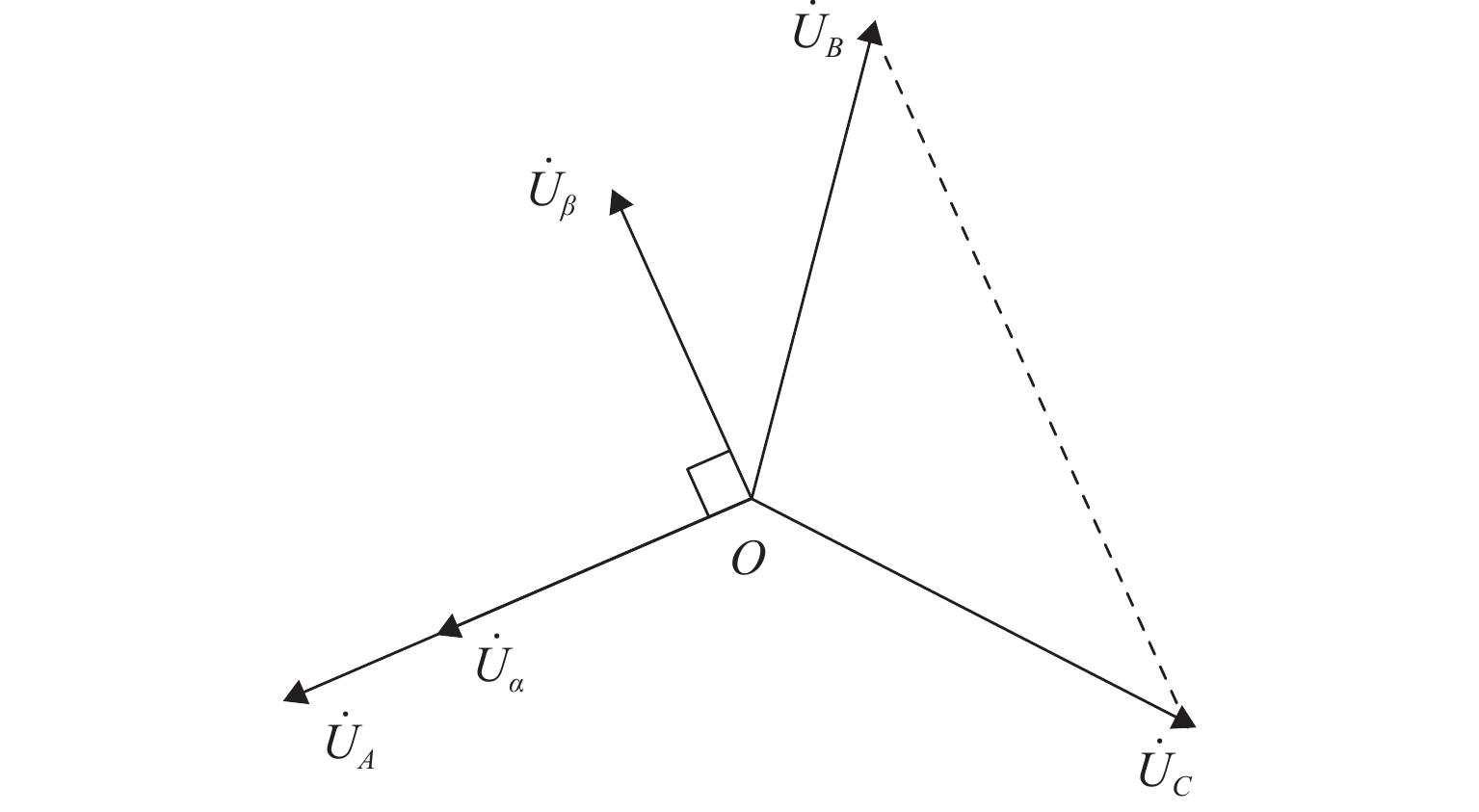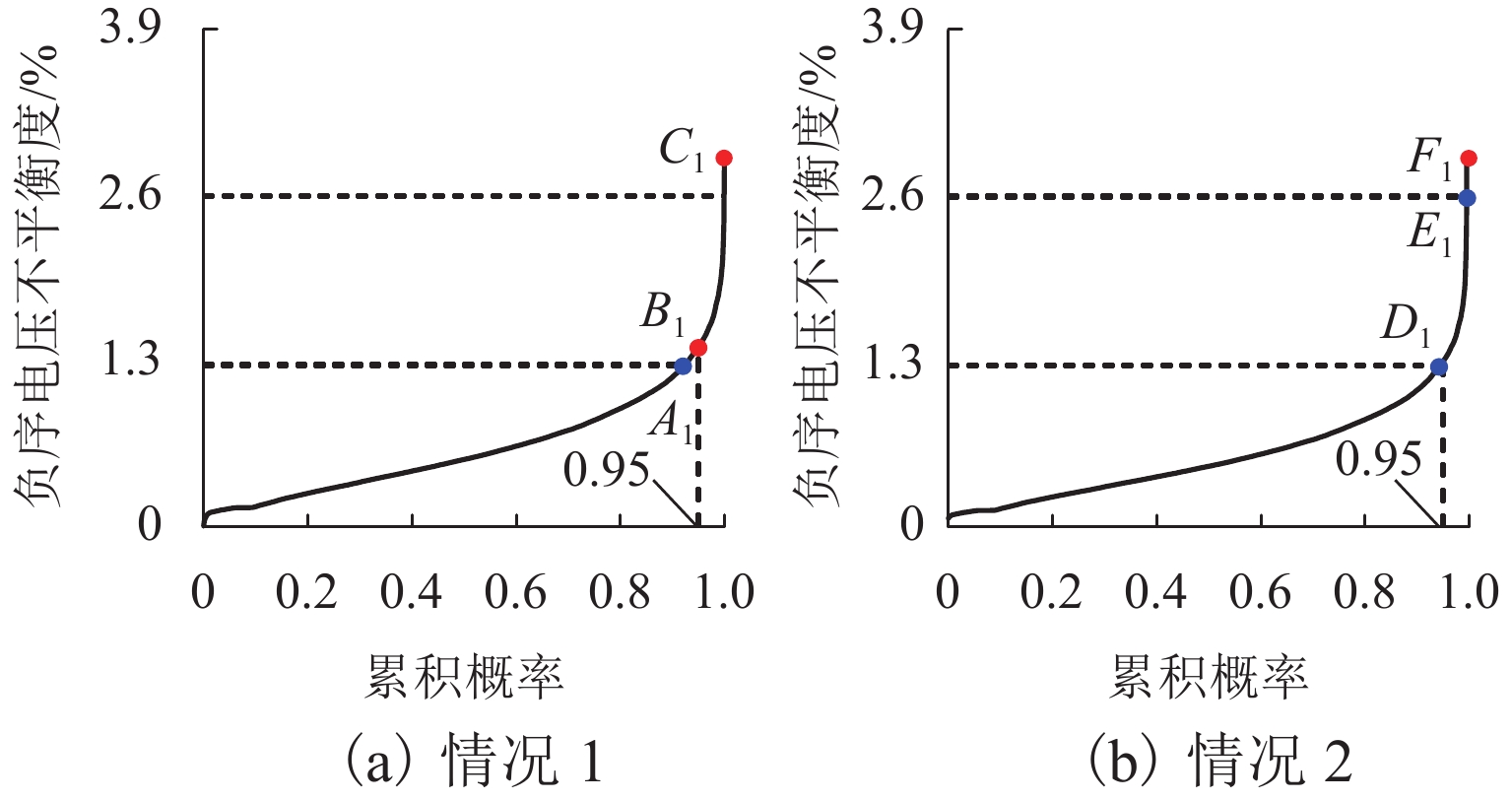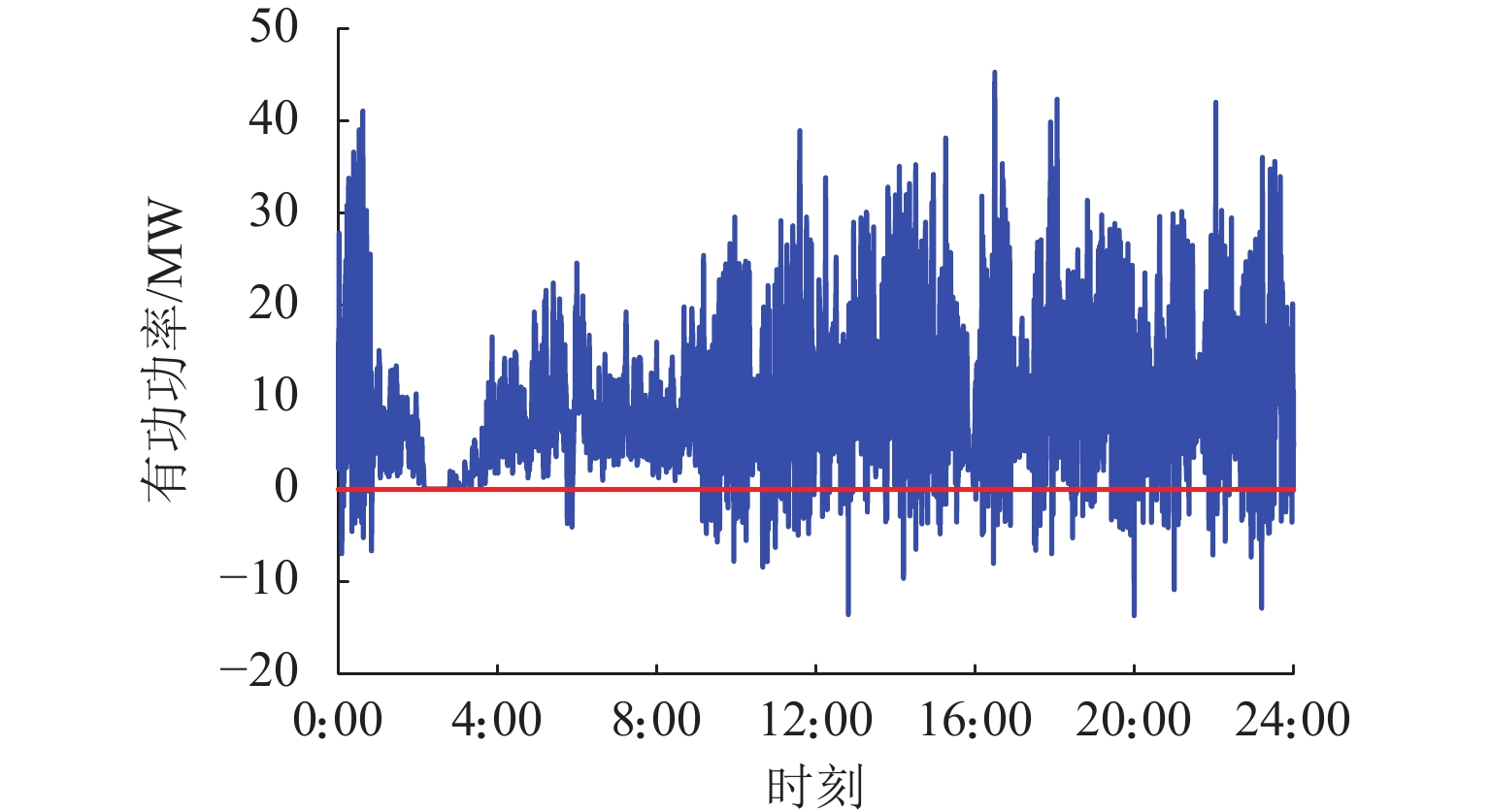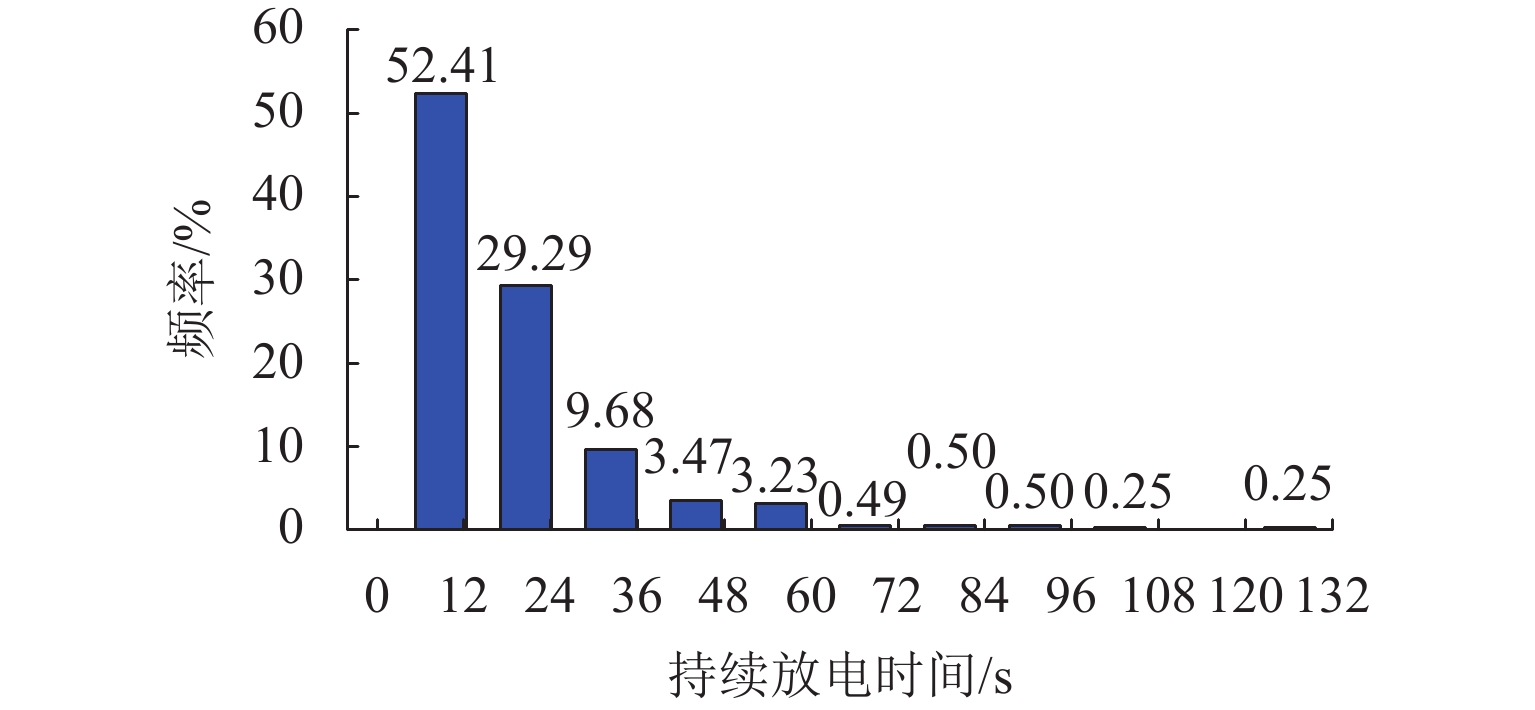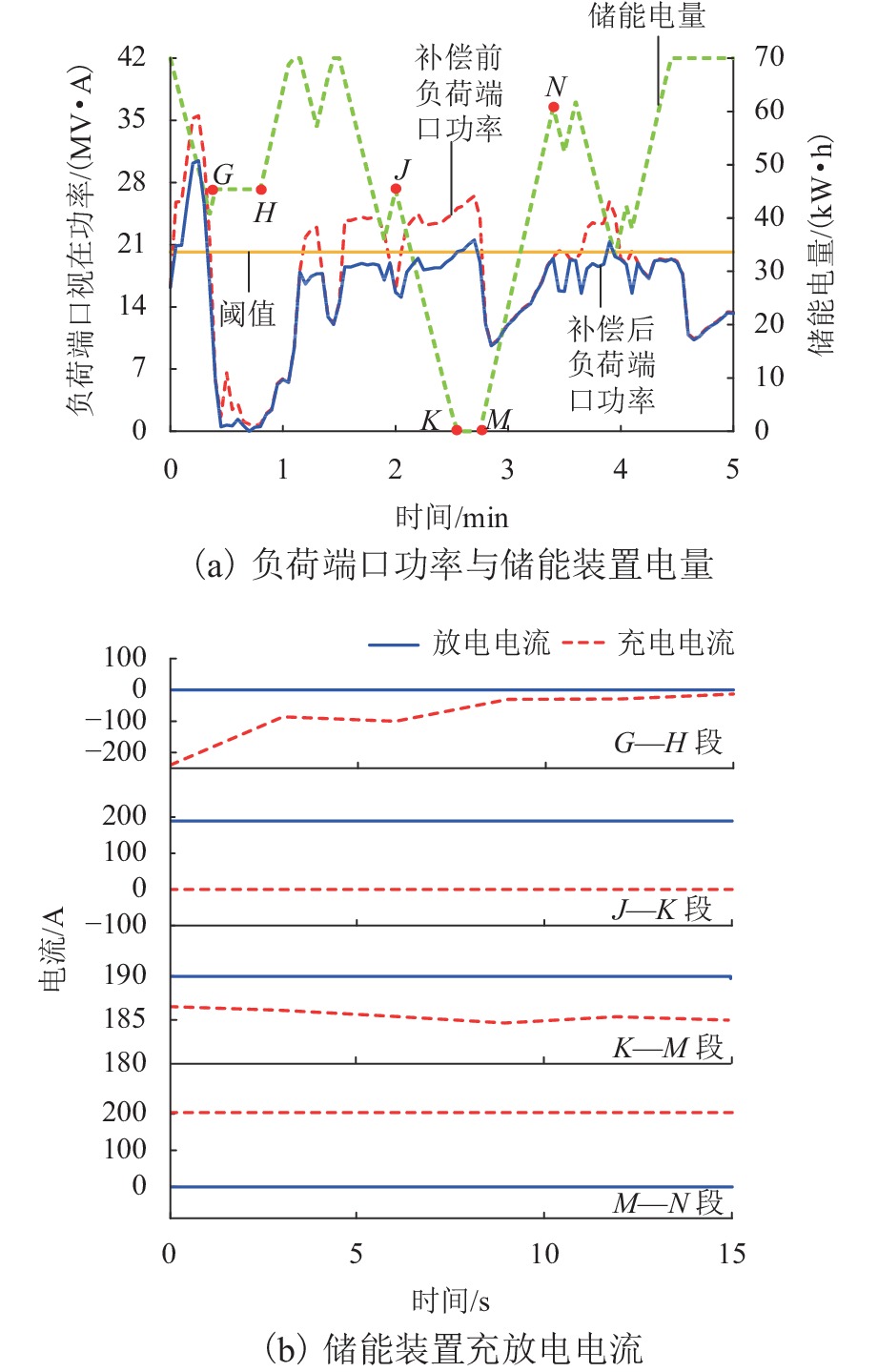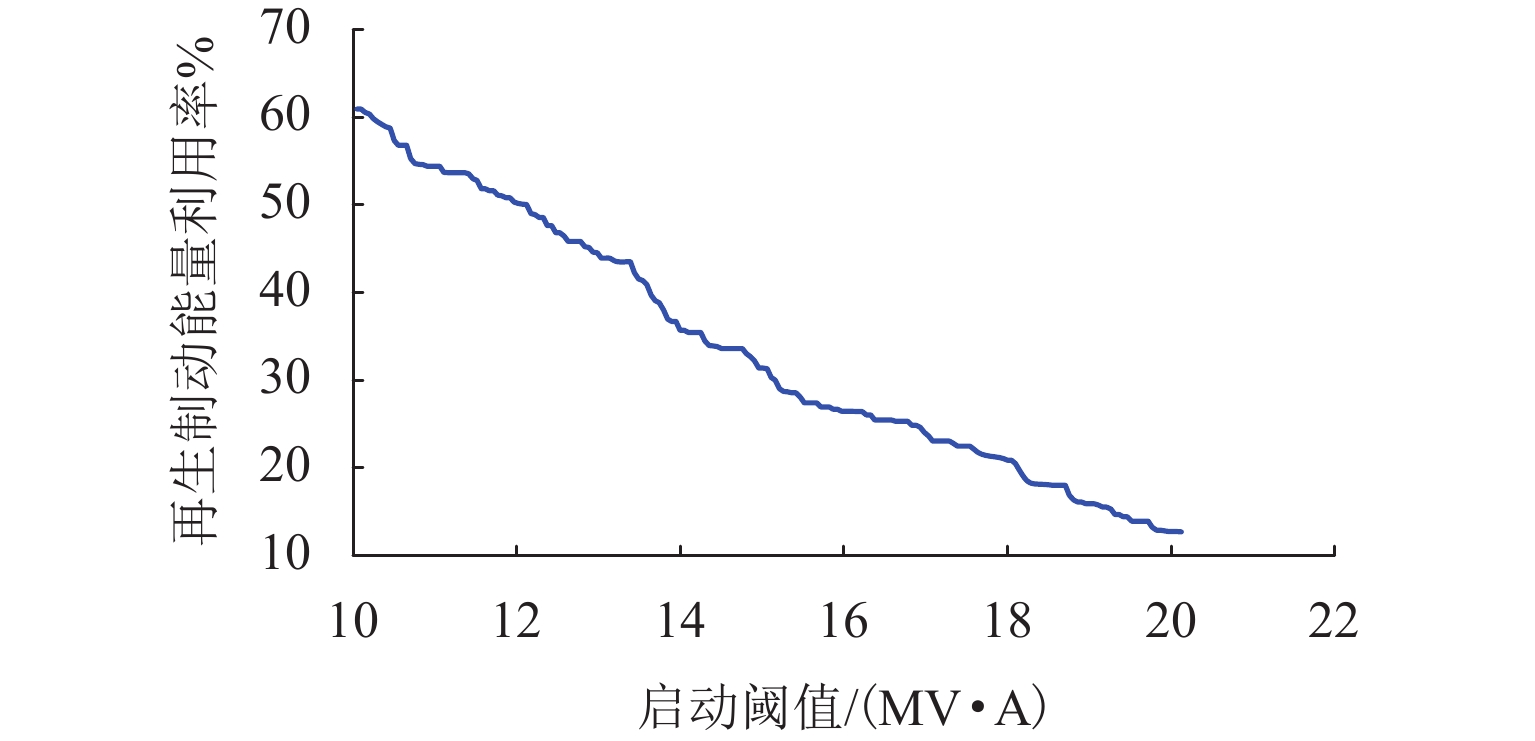Reconstruction Method of Shear Keys on Existing Bridges Based on Structural Fuse Concept
-
摘要: 因在役桥梁的抗震挡块在构造和配筋上缺乏规范的指导而限位效果低下,基于保险丝理念,通过改造挡块提高在役桥梁抵抗地震破坏的潜能. 首先通过拟静力试验,验证了经特定构造和配筋处理的挡块可满足保险丝理念的要求;然后,结合试验,根据滑移剪切机理建立了改造挡块的强度计算公式,并由此提出了改造挡块的具体实施细节和流程;最后,通过实桥模拟,对比分析了改造挡块的限位和传力效果. 研究结果表明:改造挡块发生大位移延性滑移剪切破坏,不会对盖梁/台帽造成损伤;改造挡块在不同设计参数下仍可采用统一的强度计算公式进行分析,计算误差普遍低于10%,大部分低于5%;实桥分析显示在E1和E2地震作用下改造挡块可使梁端侧移分别降低13.5%和22.0%,支座横向变形分别降低83.1%和45.8%;改造挡块在E1地震下处于完全弹性状态,在E2地震下处于强度退化状态,发挥了结构保险丝的作用.Abstract: Shear keys in existing bridges are ineffective in controlling the seismic displacement due to the lack of design codes to guide the details of construction and reinforcement. To improve the ability of existing bridges to resist earthquake damage, the reconstruction of shear keys based on the structural fuse concept is proposed. Firstly, quasi-static experiments are conducted to verify that the shear keys with a particular design of structural configuration and reinforcement meet the requirements of the structural fuse concept. Then, a prediction model is proposed to calculate the strength of shear keys based on the sliding shear mechanism, and the detailed procedures are presented for the reconstruction of shear keys. Finally, numerical simulations according to an actual bridge are performed to comparatively examine the effects of displacement control and force transfer of the reconstructed shear keys. The results show that the failure of reconstructed shear keys in a ductile mode with sliding shear and a large sliding displacement, causes no damage to the cap beam/stem wall. The strength of shear keys can be predicted accurately with a unified equation for different design parameters. The prediction errors of the equation are lower than 10% and most of them lower than 5%. Numerical simulations reveal that under the earthquakes of E1 and E2 levels, the reconstructed shear keys can decrease the lateral displacement of superstructure by 13.5% and 22.0%, respectively, and reduce the transverse deformation of laminated rubber bearings by 83.1% and 45.8%, respectively. The reconstructed shear keys remain perfectly elastic under the earthquake of E1 level and experience strength degradation under the earthquake of E2 level, which plays the role of structural fuse.
-
Key words:
- bridges /
- shear key /
- experiments /
- structural fuse concept /
- reconstruction /
- numerical simulation
-
国内电气化铁路普遍采用工频单相交流供电制式,电力牵引负荷波动性大、不对称性强,机车取流情况实时变化,导致牵引变电所的日平均负荷功率与短时最大负荷功率相差甚大[1]. 目前,由于交直交型列车得到广泛应用,使谐波和功率因数问题得到有效改善,而随着列车牵引功率的提高,负序问题愈发严重[2]. 为解决负序问题,通常采用异相有源补偿和同相有源补偿两种方式,异相有源补偿方案[3-4]虽取得了一定的负序补偿效果,但未能取消牵引变电所出口处存在的电分相,不利于系统的高效安全运行. 组合式同相供电技术由国内学者首次提出[5],牵引变电所采用单相牵引变压器、借助匹配变压器辅以必要的负序补偿装置,在消除电分相的同时取得了良好的负序治理效果[6].
目前,储能技术在铁路中的应用研究主要集中在再生制动能量回收利用[7-8]和牵引负荷削峰填谷两方面[9-10]. 同相供电时,将储能装置与牵引母线挂接,可实现削峰填谷,进而改善负序[9]. 基于此,文献[10]提出了以飞轮作为储能设备,将日负荷以15 min为周期分为96段,根据每段负荷峰谷特点设置储能装置启动阈值的方案,但该方案改善负序的能力有限,不适于电能质量较差的线路,且飞轮储能造价和维护成本较高. 超级电容以其高功率密度、高循环充放电寿命和极低维护量的特点,被广泛应用于城轨交通回收利用再生制动能量和稳定电压[11]. 针对文献[10]所提方案的不足,结合组合式同相供电技术的优越性和超级电容良好的性能特点,文献[12]提出了一种用于电气化铁路的同相储能供电方案. 基于此,文献[13]提出了一种储能式同相供电控制策略,该策略实现了再生制动能量的高效利用,但其负序治理能量依旧有限,也未能给出储能容量配置方法.
本文首先分析了同相储能供电系统的负序补偿原理;其次,以补偿负序至国标要求为目标,在负序电压不平衡度不同超标情况下,明确了储能装置的启动阈值;然后,考虑储能系统多种运行工况,建立了负序补偿模型;再以电能质量考核指标为约束,给出了储能装置充放电电流计算方法;最后,结合某牵引变电所负序补偿分析过程,给出了储能装置容量配置方案,并验证了所提同相储能供电系统能量管理策略和容量配置方案的可行性.
1. 同相储能供电系统
单相组合式同相储能供电系统如图1所示[12],图中:
${\dot I_A}$ 、${\dot I_B}$ 、${\dot I_C}$ 分别为三相电网侧的电流;$ {\dot U_\alpha } $ 、$ {\dot U_\beta } $ 和${\dot I_\alpha }$ 、${\dot I_\beta }$ 分别为变压器二次侧的端口电压和端口电流;${\dot I_{\text{s }}}$ 为储能装置的放电电流;${\dot I_{\text{L}}}$ 为牵引母线的电流. 该系统主要由牵引变压器、匹配变压器、基于多电平换流器(modular-multilevel-converter,MMC)的储能系统以及测控单元组成. 其中,储能系统又包括系统侧变流器、超级电容储能装置和负荷侧变流器,MMC可工作在高电压、大功率的场合[14]. 牵引变压器采用单相变压器,可实现牵引变电所供电范围内同相供电,取消牵引变电所出口处的电分相环节;匹配变压器与储能系统构成有功补偿支路;测控单元测得牵引变电所运行负荷功率数据,主要包括牵引母线电压、电流、功率等,并通过对比阈值功率与实测负荷实现对储能系统启停实时控制.系统利用储能装置的削峰特性,借助双向换流器:一方面在实测负荷大于阈值时,通过储能系统对牵引母线转移有功功率来降低负序电流;另一方面,在实测负荷小于阈值或列车制动时对储能装置充电. 匹配变压器与牵引变压器为不等边Scott连接,其电压矢量关系如图2所示,图中,
${\dot U_{{A}}}$ 、${\dot U_{{B}}}$ 和${\dot U_{{C}}}$ 分别为电网侧三相电压.2. 计及负序补偿的能量管理策略
2.1 储能装置启动阈值
国家标准《电能质量 三相电压不平衡》(GB/T 15543—2008)[15]规定:接于公共连接点的每个负荷在公共连接(point of common coupling,PPC)点处引起的负序电压不平衡度的95%概率大值
${\varepsilon _{{\text{U}}95\% }}\leqslant $ 1.3%,其最大值${\varepsilon _{{\text{U}}\max }} \leqslant $ 2.6%. 对于任意单相负荷,其引起的负序电压不平衡度与负荷功率成正比. 若当负荷功率大于某一功率${\;\;S _{\text{ε}} \;\;}$ 时,负序便超标,即可设置${\;\;S _{\text{ε}} \;\;}$ 为储能装置的启动阈值功率. 此时,由牵引变压器和储能装置共同承担负荷功率,限制牵引变压器功率在${\;\;S _{\text{ε}} \;\;}$ 之下,以达到降低负序的目的.储能装置启动阈值的选择存在以下两种情况,结合图3所示的负序电压不平衡度排列曲线(负序电压不平衡度由小到大排列形成)进行说明[16].
图3中:B1、D1分别为情况1、2的负序电压不平衡度95%概率大值点;C1、F1分别为情况1、2的负序电压不平衡度最大值点; A1和E1分别为三相电压不平衡度等于 1.3% 和2.6%时对应的负序电压不平衡度值点. 记图3中特殊点处的负序电压不平衡度分别为
$ {\varepsilon }_{\text{U}x}\;(x={A}_{1},{B}_{1},{C}_{1},{D}_{1},{E}_{1},{F}_{1}) $ .1)
${\varepsilon _{{\text{U95\% }}}} > 1.3{\text{%}} $ 时:如图3(a)所示,${\varepsilon _{{\text{U}A_1}}} = 1.3{\text{%}}$ 且${\varepsilon _{{\text{U}B_1}}} > 1.3{\text{%}}$ ,此时不论${\varepsilon _{{\text{U}C_1}}}$ 是否大于2.6%,为确保负序不超过国家限制,需限制牵引变压器功率不超过点A1对应的负荷功率,即应选择三相电压不平衡度等于1.3%时对应的负荷功率为阈值;2)
${\varepsilon _{{\text{U95\% }}}} < 1.3{\text{%}} $ 且${\varepsilon _{{\text{Umax}}}} > 2.6{\text{%}} $ 时:如图3(b)所示,${\varepsilon _{{\text{U}E_1}}} = 2.6{\text{%}}$ ,${\varepsilon _{{\text{U}D_1}}} < 1.3{\text{%}}$ 且${\varepsilon _{{\text{U}F_1}}} > 2.6{\text{%}}$ ,同理,此时需限制牵引变压器功率不超过点E1对应的负荷功率,即应选择三相电压不平衡度等于2.6%时对应的负荷功率为阈值.2.2 系统负序补偿模型
2.2.1 通用负序电流计算
以
${\dot U_{A}}$ 为基准,记牵引端口y的电压${U_y}$ 与电网侧线电压之比为$ {k_y} $ ,即ky=Uy√3UA,y=1,2,⋯,n, (1) 式中:n为牵引负荷端口数.
设
${\psi }_{y}=\angle ({\dot{U}}_{A},{\dot{U}}_{y})$ 为端口$y$ 的接线角,$ {\varphi }_{y}= \angle ({\dot{U}}_{y},{\dot{i}}_{y}) $ 为端口功率因数角,即˙Uy=Uye−jψy=√3UAkye−jψy, (2) ˙iy=iye−j(ψy+φy), (3) 式中:
${ i_y}$ 为端口y的瞬时电流.当n个独立的牵引负荷端口共同作用时,牵引负荷注入三相电力系统A相的负序电流为[17]
˙i−=1√3n∑y=1kyiye−j(2ψy + φy). (4) 当牵引变压器为三相-两相变压器时,次边有两个独立端口,记为
$\alpha$ 、$\beta$ (此时$y=\alpha,\beta $ ),则可得到牵引变电所在PCC处引起的负序电流:˙i−=1√3(kαiαe−j(2ψα + φα)+kβiβe−j(2ψβ+φβ)). (5) 对应图1所示的组合式同相储能供电系统,变压器二次侧各电流的有功分量(用下标p表示)和无功分量(用下标q表示)分别为
{iαp=iαcosφα,iαq=iαsinφα,iβp=iβ,iβq=0,isp=is,isq=0,iLp=iLcosφL,iLq=iLsinφL, (6) 式中:
${\varphi _{\text{L}}}$ 为负荷功率因数角;${\dot U_{\text{L}}}$ 为牵引母线电压;is、iL分别为储能装置的放电瞬时电流、牵引母线的瞬时电流.当储能装置工作时,次边电流满足式(7).
{iαp+is=iLp,iαq=iLq. (7) 联立式(5)~(7),负序电流可表达为
i−=k√3[(iLp−is)2+2iLpiβsin(2ψβ−2ψα)+i2β+2(iLp−is)iβcos(2ψβ−2ψα)+i2Lq]1/2, (8) 式中:
$k = {k_\alpha } = {k_\beta}$ .当牵引变压器与匹配变压器为Scott接线时,同相储能供电系统注入PCC处的负序电流通用表达式,如式(9)所示.
i−=k√3[(iLp−is)2+i2Lq+i2β−2(iLq−is)iβ]1/2. (9) 2.2.2 典型工况下系统负序分析
同相储能供电系统存在4种不同工况,如图4所示;且不同工况下同相储能供电系统对三相电力系统的负序影响不同,如图5所示. 图4、5中:
${i_{{\beta\text{0}}}}$ 、${i_{{\beta\text{1}}}}$ 和${i_{{\beta\text{2}}}}$ 分别为不同状态下的储能装置充电电流;${i'_{\text{L}}}$ 为机车制动时返回牵引变压器的电流;$\dot U^ - _{A}$ 为${\dot U_{A}}$ 对应的负序分量;$ \dot U_{AB}^ - $ 为A相与B相电压差${\dot U_{AB}} $ 对应的负序分量,其余变量类推.1) 工况1 (储能装置待机)
实时负荷功率小于或等于阈值,且储能装置满电时,储能装置待机,工况如图4(a)所示. 牵引负荷由牵引变压器承担,此时
$ {i}_{\text{s}}= 0; {i}_\beta= 0 $ ,负序电流为i−=1√3kiL, (10) 其负序相量图如图5(a)所示.
2) 工况2 (储能装置放电)
实时负荷功率大于阈值,且超级电容有剩余电量时,设置牵引侧变流器处在逆变工况,配合超级电容放电,削降负荷峰值,补偿负序,系统工况如图4(b)所示. 此时
${i_\beta } = 0$ ,负序电流为i−=1√3k[(iLp−is)2+iLq2]1/2, (11) 其负序相量图如图5(b)所示.
3) 工况3 (储能装置外接)
实时负荷功率大于阈值且超级电容剩余电量为0时,设置系统侧变流器处于整流工况、牵引侧变流器处于逆变工况,联合匹配变压器构成一个补偿通路,降低牵引变压器承担的负荷峰值,系统工况如图4(c). 此时,充电电流
${i_{{\beta\text{0}}}}$ 与放电电流${i_{\text{s }}}$ 之间满足功率守恒,即${u_\beta}{i_{{\beta\text{0}}}}{\text{ = }}\;{u_{\text{L}}}{i_{\text{s}}}$ ,其中,${u_\beta} $ 和${u_{\text{L}}}$ 分别为变压器二次侧端口β瞬时电压和牵引母线瞬时电压,系统引起负序电流大小为i−=k√3[(iLp−is)2+iLq2+iβ02+2(iLq−is)iβ0]1/2, (12) 其负序相量图如图5(c)所示.
4) 工况4 (储能装置充电)
负荷功率小于阈值功率或列车处于再生制动状态,且超级电容电量不满时,储能装置处于充电状态,故有电网充电和再生制动充电两种工况.
电网充电:系统工况如图4(d)所示,此时
${i_{\text{s}}}{\text{ = 0}}$ ,电网提供充电电流${i_{{\beta\text{1}}}}$ ,PCC处负序电流值为i−=k√3(iLp2+iLq2+iβ12+2iLqiβ1)1/2, (13) 其负序相量图如图5(d)所示.
再生制动充电:当列车处在再生制动工况时,系统工况如图4(e)所示. 再生制动能量先经变流器储存在超级电容中,剩余的能量再经牵引变压器返回三相电网. 制动时返回牵引变压器的电流
${\dot i'_{\text{L}}}$ 、返回储能装置的充电电流${\dot i_{{\beta\text{2}}}}$ 满足式(14).˙i′L+˙iβ2=˙iL, (14) 其负序电流为
i−=1√3ki′L, (15) 其负序相量图如图5(e)所示.
2.3 储能装置的充放电电流
若使用超级电容作为储能装置,可采用恒流充放电模式[18],以满足三相电压不平衡度
${\varepsilon _{\text{U}}}$ 限值为条件,计算充、放电电流.2.3.1 放电电流
记PCC点处负序电压不平衡度为
εU=√3i−UsSd×100%, (16) 式中:
${S _{\text{d}}}$ 为PCC点的三相短路容量,V·A;${U_{{\rm{s}}}}$ 为电网电压,V.根据式(16),可计算得到国标允许负序电流的95%概率大值和最大值,分别记为
$I_{95{\text{%}} }^ - $ 和$I_{\max }^ - $ ,记实际负序电流95%概率大值和最大值分别为$ I_{{{{\text{ε}} \;95{\text{%}} }}}^ - $ 和$ I_{{{{\text{ε}} \;\max}}}^ - $ ,补偿两者至国标限值$I_{95{\text{%}} }^ - $ 和$I_{\max }^ - $ 所需补偿电流分别为${I_{{\text{s }}95{\text{%}} }}$ 和${I_{{\text{s max}}}}$ .根据不同的负序超标状态,应分3种情况确定放电电流
$ {I_{\text{s}}} $ 的大小:1)
$ {I}_{\text{ε 95\%}}^{-} > {I}_{95{\text{%}}}^{-},{I}_{\text{ε max}}^{-} > {I}_{\mathrm{max}}^{-} $ 时,分别令{1√3k[(iLp 95\% −is)2+iLq 95\% 2]1/2⩽I−95%,1√3k[(iLp max−is)2+iLq max2]1/2⩽I−max, (17) 式中:
$ {i_{{\text{Lp 95\% }}}} $ 和$ {i_{{\text{Lq 95\% }}}} $ 分别为三相不平衡度为图3中点B1所对应负荷的有功和无功分量;同理,$ {i_{{\text{Lp max}}}} $ 和$ {i_{{\text{Lq max}}}} $ 分别为点D1对应负荷的有功和无功分量.求解式(17)得
{is⩾Is 95\% ,is⩾Is max. (18) 为确保能补偿最大负序超标情况,取
${I}_{\text{s}}= \mathrm{max}\left\{{I}_{\text{s 95\%}},{I}_{\text{s }\mathrm{max}}\right\}$ .2)
${I}_{\text{ε 95\%}}^{-} > {I}_{95{\text{%}}}^{-},{I}_{\text{ε max}}^{-} < {I}_{\mathrm{max}}^{-}$ 时,令1√3k[(iLp 95\% −is)2+iLq 95\% 2]1/2⩽I−95\% , (19) 解得
${I_{\text{s}}} \geqslant {I_{{\text{s 95\% }}}}$ ,同理则取${I_{\text{s}}} = {I_{{\text{s 95\% }}}}$ .3)
$ {I}_{\text{ε 95\%}}^{-} < {I}_{95{\text{%}}}^{-},{I}_{\text{ε max}}^{-} > {I}_{\mathrm{max}}^{-} $ 时,则同理可得Is⩾Is max, (20) 此时取
${I_{\text{s}}} = {I_{{\text{s max}}}}$ .2.3.2 充电电流
列车处于再生制动工况时,充电电流取决于再生制动功率的大小,储能装置外接时,充电电流
${i_{{\beta\text{0}}}}$ 由${u_\beta}{i_{{\beta\text{0}}}}{\text{ = }}{u_{\text{L}}}{i_{\text{s }}}$ 求得.充电电流
${i_{{\beta\text{1}}}}$ 来自电网时,充电电流受到三相电压不平衡度限值影响,负序电流满足式(21).{1√3k(i2Lp 95\% +i2Lq 95\% +i2β1+2iLq 95\% iβ1)1/2⩽I−95%,1√3k(i2Lp max+i2Lq max+i2β1+2iLq maxiβ1)1/2⩽I−max, (21) 解得
{iβ1⩽Iβ1 95\% ,iβ1⩽Iβ1 max, (22) 式中:
$I_{{\beta\text{1 95\% }}} $ 和$I_{{\beta\text{1 max}}} $ 分别为充电电流的95%概率大值和其最大值.为确保储能装置从三相电网取流时负序不超标,则充电电流
${I}_{\beta\text{1}}=\mathrm{min}\left\{{I}_{\beta\text{1 95\%}},{I}_{\beta\text{1 max}} \right\}$ .3. 实例分析
以某牵引变电所的实测数据为例,牵引变压器变比为110.0 kV/27.5 kV,牵引变压器额定容量为31.500 MV·A,短路电压百分比
$ {U_{\text{d}}} = 10.5{\text{%}} $ . 系统短路容量为1 650.000 MV·A. 牵引变电所24 h实测有功功率变化曲线如图6所示.图6中有功功率为正表示列车处于牵引工况,牵引变电所从电力系统中吸收电能,瞬时最大牵引功率为45.28 MW;功率为负则表示列车处于再生制动工况,瞬时最大再生制动功率为13.74 MW.
3.1 储能容量配置
补偿前牵引变电所负序电压不平衡度的95%概率大值和其最大值分别为
${\varepsilon _{{\text{U 95\% }}}} = 1.418{\text{%}} $ 和${\varepsilon _{{\text{U max}}}} = 2.913{\text{%}} $ ,均超出国标限值. 选择负序电压不平衡度等于1.3%所对应的负荷功率20.172 MV·A为储能装置启动阈值,补偿95%概率大值电压不平衡度所需的补偿电流为${I_{{\text{s 95\% }}}}{\text{ = }}71.5$ A,补偿电压不平衡度最大值所需补偿电流为$ {I_{{\text{s max}}}} = 189.4 $ A,对应计算放电电流的第一种情况,储能装置放电电流${I}_{\text{s}}= \mathrm{max}\left\{{I}_{\text{s 95\%}},{I}_{\text{s max}}\right\}\text\;{=}\;189.4$ A.假设超级电容工作在负荷功率小于阈值则充电、大于阈值则放电的极端条件下,则充电电流
${I}_{\beta {1}}=\mathrm{min}\left\{ {I}_{\beta \text{1 95\%}},{I}_{\beta \text{1 max}}\right\}\text\;{=}\;203.0$ A. 又因${I_{\text{s }}}{\text{ = }}\;189.4$ A、功率满足${U_\beta}{I_{{\beta\text{0}}}}{\text{ = }}\;{U_{\text{L}}}{I_{\text{s }}}$ 、电压满足${U_\beta} \approx {U_{\text{L}}}$ ,故${I_\beta}= \mathrm{max}\left\{{I}_{\beta\text{0}},{I}_{\beta\text{1}}\right\}\text{=}203.0$ A. 该启动阈值下,储能装置每次放电持续时间频率分布统计如图7所示.由图7易见:最长放电时间为132 s;放电时间在0~48 s范围内,占统计结果的94.78%. 牵引供电电能质量分析中,95%概率大值应用广泛[7],故确定超级电容的可供连续放电时间为48 s. 当储能装置放电电流为189.4 A、持续放电时间为48 s时,超级电容可存储电量至少为
189.4×27.5×48/3600=69.40kW·h. 3.2 分析验证
假设牵引变电所安装的超级电容储能系统的规格为15 MW/70 kW·h.
3.2.1 能量分配情况
基于同相储能装置的控制策略和容量配置方案,结合与列车运行状态相关的牵引变电所实测数据,分析该同相储能供电系统工作效果.
选取变电所某时段负荷功率和储能装置电量变化如图8(a)所示,储能装置充放电电流情况如图8(b)所示. 对应同相储能供电系统的5种工况,将负荷功率和储能装置电量变化曲线划分为5个阶段.
1) G—H段(储能装置由再生制动充电)
由图8(b):在该时段,放电电流
${I_{\text{s }}}{\text{ = }}\;0$ ,充电电流${I_\beta}$ 为负表示充电电流由再生功率提供,对应图8(a),储能装置吸收再生能量,储能电量由45.39 kW·h稳步上升至45.41 kW·h.2) J—K段(储能装置放电补偿)
由图8(a)和8(b)可见,负荷功率大于阈值,补偿功率全部由储能装置提供,充电电流为0、放电电流恒为189.4 A,储能装置电量由45.30 kW·h降至0.
3) K—M段(储能装置外接)
由图8(a),负荷功率大于阈值,储能装置电量为零,又由图8(b)得,放电电流
${I_{\text{s }}}$ 恒为189.4 A,充电电流${I_{{\beta }}}$ 约为186.0 A.4) M—N段(储能装置由三相电网充电)
从图8(a)可知,负荷功率小于阈值功率,储能装置电量从0上升至66.09 kW·h;同时,由图8(b)可见,放电电流
${I_{\text{s }}}{\text{ = }}\;0$ 、充电电流${I_\beta}{\text{ = }}203.0$ A.3.2.2 总体安装效果
安装储能装置前后,PCC处的三相电压不平衡度排列曲线如图9所示. 储能前后负序电压不平衡度的95%概率大值由点R的1.418%补偿至点P的1.188%,最大值由点V的2.913%降至点Q的2.600%,补偿负序效果良好.
补偿前后,牵引变电所总功率日变化曲线见图10,最大瞬时功率由45.600 MV·A降至41.240 MV·A,储能装置实现了负荷削峰效果.
分析再生制动能量利用情况如图11所示.
易知,列车在统计周期内制动109次,其中,储能装置吸收再生制动能量32次. 定义节能率为[12]
节能率=吸收的再生制动能量总再生制动能量×100%. (23) 经计算,总再生制动能量为1495.24 kW·h,装置吸收的总再生制动能量为229.32 kW·h,节能率为15.1%.
基于本文的案例数据,分析了当储能容量一定时,在不同启动阈值下,同相储能供电系统的再生制动能量利用率,如图12所示.
由图12可以发现:当储能容量一定时,节能率和储能装置启动阈值之间负相关:启动阈值越高,节能率越低. 在本文中,由于选取阈值时,优先考虑了负序补偿效果,故而存在再生制动能量利用率较低的问题,下一步将对储能容量和启动阈值进行优化.
4. 结 论
本文介绍了一种带储能装置的电气化铁路同相供电方案,通过负序补偿理论分析,表明该方案能显著改善负序,并在论文中给出了储能装置的能量管理策略和容量配置方案;最后结合实际牵引变电所统计数据,验证了其有益效果,得到结论如下:
1) 当三相电压不平衡度的95%概率大值超标,或者95%概率大值与最大值均超标时,选取三相电压不平衡度等于1.3%时对应的负荷功率为阈值功率;仅三相电压不平衡度最大值超标时,选择三相电压不平衡度等于2.6%时对应的负荷功率为阈值功率.
2) 储能装置通过有功补偿对负荷进行削峰,负序补偿效果取决于储能装置的放电功率大小,放电功率越大,负序补偿效果越好,在国标限值的约束下,设置补偿目标,补偿效果良好.
3) 储能装置既能补偿负序,又可兼顾再生制动能量的回收利用,储能容量一定时,充放电阈值的大小不仅影响负序补偿,同时影响再生能量的利用率. 在案例分析中,储能装置可回收利用15.1%的再生能量,尚需对储能容量和启动阈值进行优化,在实现负序补偿的同时,提高再生制动能量利用率.
-
表 1 试件设计参数
Table 1. Design parameters of specimens
试件
编号混凝土
标号接触面
尺寸/mm剪切钢筋 底座拉筋 挡块预估
强度[7]/kN拉筋抗拉能力/
挡块预估强度1# C40 300 × 500 HRB400, 5  12
12HRB400, 6  20
20423.6 2.04 2# C40 300 × 500 HRB400E, 5  12
12HRB400, 6  20
20411.5 2.10 3# C40 300 × 500 HRB400, 4  12
12HRB400, 6  20
20359.9 2.40 4# C50 300 × 500 HRB400, 5  12
12HRB400, 6  20
20423.6 2.04 5# C40 300 × 500 HRB400E, 3  12
12HRB400, 6  20
20288.9 2.99 6# C40 300 × 500 HRB400E, 2  20
20HRB400, 6  20
20446.2 1.94 7# C40 300 × 500 HRB400E, 3  16
16HRB400, 6  20
20428.0 2.02 8# C40 250 × 500 HRB400, 5  12
12HRB400, 6  20
20406.1 2.13 9# C40 350 × 500 HRB400, 5  12
12HRB400, 6  20
20441.1 1.96 10# C30 300 × 500 HRB400, 5  12
12HRB400, 6  20
20423.6 2.04 表 2 试验结果与理论强度
Table 2. Test results and theoretical strengths
试件编号 混凝土强度/MPa 剪切钢筋强度/MPa 挡块实测
强度/kN滑移位移/
mm挡块理论
强度/kN误差/% 拉筋抗拉能力/
挡块实测强度底座 挡块 屈服 极限 1# 56.8 53.0 468 633 207.3 82 198.3 −4.35 4.17 2# 56.8 53.0 448 609 178.6 103 189.8 6.27 4.83 3# 56.8 53.0 468 633 152.1 75 158.6 4.29 5.68 4# 52.3 52.8 468 633 204.8 64 198.3 −3.18 4.22 5# 56.8 53.0 448 609 131.0 — 113.9 −13.07 6.59 6# 56.8 53.0 458 610 148.0 40 150.9 1.98 5.83 7# 56.8 53.0 448 602 155.7 69 151.8 −2.53 5.55 8# 56.8 53.0 468 633 136.2 32 198.3 45.58 6.34 9# 56.8 53.0 468 633 200.0 62 198.3 −0.86 4.32 10# 45.7 51.7 468 633 200.2 60 198.3 −0.96 4.31 注:混凝土和钢筋强度均按材料强度标准试验测得,4#的 C50 由于配比失误,实测强度与 C40 的实测强度接近;10个 试件均未加载至完全脱落,此处滑移位移指加载中最大实测值,5#是第 1 个探索性加载对象,未记录到滑移值. -
重庆交通科研设计院. 公路桥梁抗震设计细则JTG/T B02-01—2008[S]. 北京: 人民交通出版社, 2008. 陈乐生, 庄卫林, 赵河清, 等. 汶川地震公路震害调查: 桥梁[M]. 北京: 人民交通出版社, 2012: 32-34. SILVA P F, MEGALLY S H, SEIBLE F. Seismic performance of sacrificial exterior shear keys in bridge abutments[J]. Earthquake Spectra, 2009, 25(3): 643-664. doi: 10.1193/1.3155405 VASSEGHI A. Energy dissipating shear key for precast concrete girder bridges[J]. Scientia Iranica, 2011, 18(3): 296-303. doi: 10.1016/j.scient.2011.05.036 邓开来,潘鹏,冉田苒,等. 耗能型桥梁抗震挡块试验研究[J]. 振动与冲击,2014,33(22): 7-12.DENG Kailai, PAN Peng, RAN Tianran, et al. Experimental study on energy dissipation stopper for bridge[J]. Journal of Vibration and Shock, 2014, 33(22): 7-12. 王克海, 惠迎新, 吴刚. 新型双层抗震挡块抗震性能研究[J]. 地震工程与工程振动, 2014, 34(增刊): 505-510.WANG Kehai, HUI Yingxin, WU Gang. Study on seismic performance of seismic double-layer stopper[J]. Earthquake Engineering and Engineering Dynamics, 2014, 34(S): 505-510. 徐略勤,李建中. 可牺牲抗震挡块的两水准设计方法[J]. 中国公路学报,2015,28(10): 59-66. doi: 10.3969/j.issn.1001-7372.2015.10.008XU Lueqin, LI Jianzhong. Dual-level design method of sacrificial aseismic retainers[J]. China Journal of Highway and Transport, 2015, 28(10): 59-66. doi: 10.3969/j.issn.1001-7372.2015.10.008 HAN Q, ZHOU Y L, OU Y C, et al. Seismic behavior of reinforced concrete sacrificial exterior shear keys of highway bridges[J]. Engineering Structures, 2017, 139(5): 59-70. XIANG N L, LI J Z. Seismic performance of highway bridges with different transverse unseating-prevention devices[J]. Journal of Bridge Engineering, 2016, 21(9): 1-16. 徐略勤,李建中. 新型滑移挡块的设计、试验及防震效果研究[J]. 工程力学,2016,33(2): 111-118.XU Lueqin, LI Jianzhong. Design and experimental investigation of a new type sliding retainer and its efficacy in seismic fortification[J]. Engineering Mechanics, 2016, 33(2): 111-118. CALTRANS. Caltrans seismic design criteria: version 1.7[S].California: California Department of Transportation, 2013. MEGALLY S H, SILVA P F, SEIBLE E F. Seismic response of sacrificial shear keys in bridge abutments[R]. San Diego: University of California at San Diego, 2001. BOZORGZADEH A, MEGALLY S H, ASHFORD S A, et al. Seismic response of sacrificial exterior shear keys in bridge abutments[R]. San Diego: University of California at San Diego, 2007. 阎西康,丛林,张玉淙. 不同植筋深度混凝土梁的静力试验研究[J]. 建筑科学,2016,32(11): 106-109.YAN Xikang, CONG Lin, ZHANG Yucong. Static tests on different planted depth of concrete beams[J]. Building Science, 2016, 32(11): 106-109. MAZZONI S, MCKENNA F, SCOTT M H, et al. Open system for earthquake engineering simulation: OpenSees command language manual[M]. Berkeley: Pacific Earthquake Engineering Center, 2007: 33-342. -















 下载:
下载:



































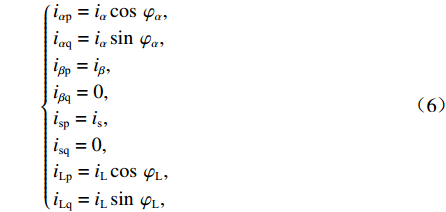
































































































 下载:
下载:
